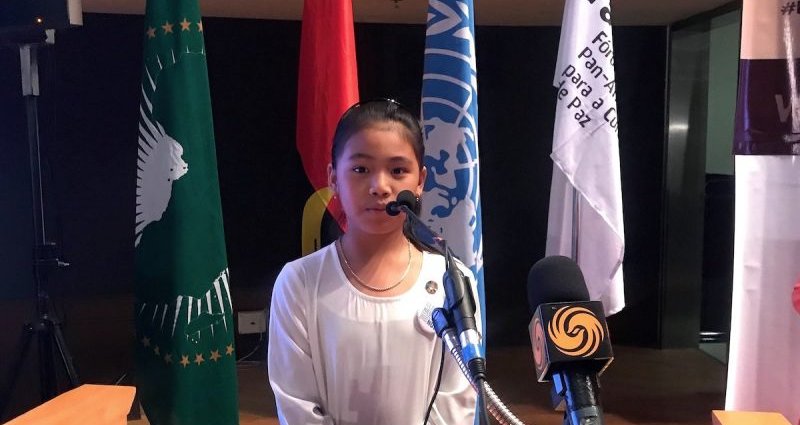The nine-year-old promotes climate consciousness and environmental accountability
Licypriya Kangujam addressing the UNESCO Partners’ Forum (Biennial Luanda) in Angola on September 20, 2019. Image by Dilanlekamge via Wikimedia Commons, CC BY-SA 4.0.
Two days before she turned nine, climate crusader Licypriya Kangujam — who has more than 93.4K followers on Twitter, over 20K followers on Facebook, and 18.6K-plus subscribers to her YouTube channel — tweeted:
I’m appealing to all the people of my birth state Manipur to plant one tree
each on 2nd October.
If 2.8 millions people of Manipur plant 2.8 millions trees on this day then it will help to fight the global climate crisis.
Receiving overwhelming great response.
pic.twitter.com/0ljyUiuXkg
— Licypriya Kangujam (@LicypriyaK) September 30, 2020
Kangujam uses these popular social media channels to champion the cause of climate justice not just in India, where she is from, but across the world. The response to her call is testimony to the support she has garnered online for her cause:
Today trees
plantation by 4 communities viz Wabagai Kadajit, Wangkhei Ningthem Pukhri Mapal, Wabagai Mayai Leikai & Sangaiyumpham part 1 for my birthday
.
Thank you everyone
#1TreeForLicyBirthday pic.twitter.com/lSsYCaPntx
— Licypriya Kangujam (@LicypriyaK) October 2, 2020
Many of Kangujam’s followers, like Nandini Dixit, a plant lover from Chhattisgarh, often take her ideas even further:
Pre birthday wishes for licypriya
Guys let’s follow this suite and plant a tree on @LicypriyaK‘s birthday on 2nd October but But on the birthday of all your dear ones . Like my grandmother’s birthday is also on 2nd October so I will plant more trees on that day. https://t.co/bBX2WlVELq pic.twitter.com/zzqqWBSR9x— Nandini Dixit (@Nandini72113762) September 28, 2020
They also lend support to the young climate activist in other tangible ways. On September 24, for instance, climate crusaders accompanied Kangujam as — true to her promise on Twitter — she sought to enter the Indian parliament in an effort to urge lawmakers to pass bills on climate change. Although the group was not given access, members staged a peaceful rally outside the parliament building in Delhi, making many sit-up and take notice:
Several national and regional dailies in India covered Kangujam’s attempt to engage lawmakers, and quoted her as saying that laws against carbon emissions and greenhouse gases can go a long way in creating climate consciousness.
Kangujam is also a fervent supporter of introducing climate change education in schools, an intervention promoted by several activists who believe that inculcating climate consciousness at a young age can be effective in reducing activities that are detrimental to the environment.
Born in Manipur in northeastern India, Kangujam now lives in Noida, a satellite town near Delhi, the capital. She took up the cudgels against climate change at the tender age of six and hasn’t given up since. Attending the Asian Ministerial Conference on Disaster Risk Reduction in July 2018 piqued her interest in the impact of climate change; her experience there encouraged her to become more involved in saving the planet.
After returning from the conference, she set up Child Movement, an India-based initiative aimed at raising awareness about climate change and tackling disasters in order to protect the planet’s future.
Since then, she has been actively organising rallies in different parts of the country and adding her voice to initiatives across the globe, visiting more than 30 countries so far. Kangujam even addressed world leaders in Madrid, Spain, at the 2019 United Nations Climate Change Conference.
Though she and Greta Thunberg are “good friends”, Kangujam has categorically refuted comparisons to the young Swedish climate activist, preferring to forge her own identity. In an interview with WION News, she explained:
People call me ‘Greta of India’, but truly I am ‘Licypriya of India’.
Given the poor air quality in Delhi and surrounding areas, Kangujam says that living in Noida has made her more climate-conscious than ever. Each winter, residents’ lungs are subjected to the merciless attack of pollutants released into the atmosphere from burning stubble, adding to the already overwhelming emissions from factories and vehicles:
In 2019, India wear single face mask
to protect from air pollution.
In 2020, India needs to wear double face masks
to protect from both air pollution & COVID19.
Last 9 months, pin drop silent & now started on media to fight air pollution.
No way now. It’s too late.
— Licypriya Kangujam (@LicypriyaK) September 29, 2020
When it comes to climate change, she wants the problems of the Global South — including India — to be recognized, without being lost in the conundrum that the rest of the world faces. She explained her position in a talk she gave at the TEDxSBSC (Shaheed Bhagat Singh College in Delhi) earlier this year:
The efforts of young Licypriya Kangujam — not to mention her huge following on social media — goes to show that youth are not ambivalent towards the issue of climate change, and that many people, of all ages, relate to the cause. It’s a silver lining that suggests hope is not lost and the world still stands a chance.












